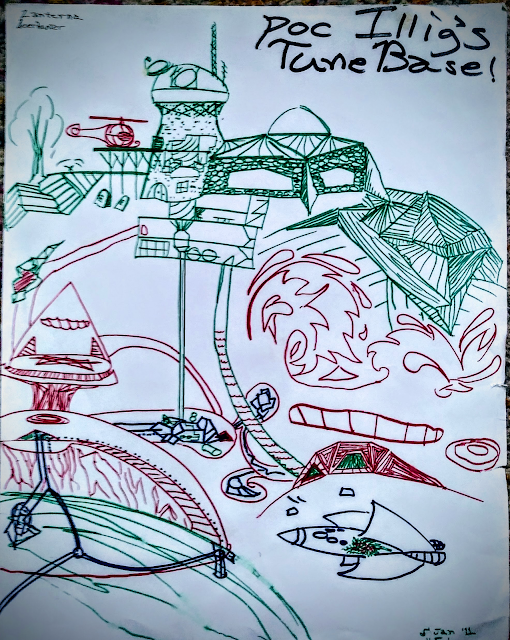Gnomes, Dwarves, Pointy Hats, & Anti-Jewish Tropes [draft]
It is "wandering" in the sense of a cultural "travelling concept" that changes significance as it is transferred from one place and time to another.
Conical hats are attributes of royalty and divinity in near eastern art as far back as the bronze age. Kings, gods, and priests are shown in images and statues with tall, pointy hats, reaching toward heaven and increasing their stature.
People actually wear all kinds of hats, including pointy ones: Roman priests and freed slaves had separate styles, both conical; the Phrygian cap of freedmen was also worn by Mithraists (and much later, revolutionary France.)
Conical supports for turbans became court garb in the golden age of Islam, getting bigger and fancier, and the fashion for tall hats spread to Europe, with aristocrats, priests, soldiers, and wealthy merchants sporting them. The Jews of southern France, many of whom were cloth merchants with connections to the Muslim world, also wore tall fancy hats, criticized in rabbinical literature as ostentatious.
With the 12th century and the crusades, positive views of eastern fashions dried up, European headgear diverged, the bishop's miter developed two peaks instead of one. Intense persecution of Jews took off during the crusades, with much more anti-jewish imagery appearing in books, sculpture, and poetry than before; and unfashionable pointy hats associated with the infidel proliferated in such art.
13th C laws across the Holy Roman Empire required Jews to wear conical hats; this happened alongside similar laws in other countries, like the obligation to wear a badge of two tablets in England. Compliance varied of course, with Jews in some areas resisting and testing municipal control, and others embracing the hat as a badge of community and piety.
Into the 14th and 15th C, various Christian criminals had to wear pointed hats: sorcerers, women who had sex with Jews, usurers. In art, the pointed hat spreads to other untrustworthy people: heathens, thieves, ogres, magicians, and dwarves—with real people with dwarfism mostly obscured by mythical dwarfs.
Dwarfs were fabled to manipulate human sight. They could disappear and reappear at will, and they could also make humans blind, temporarily or permanently.
Hmm illusions much?
Depictions of dwarves in caps, and dwarfish tricksters, proliferate in art and minstrel songs in the 13th century, the same period as Jews were being required to wear distinctive hats.
in the early manuscripts of the Nibelungenlied, the dwarf Alberich is said to wear a tarnkappe, or "concealing cape," according to the original sense of the word kappe. Alternatively, the magical garment is termed tarnkleit, or "concealing cloak,"... By the sixteenth century at the latest the word kappe had begun to designate a "cap," and the "invisibility cape" morphed into a "visibility cap"... the tarnkappe is interpreted as a torenkappe, or fool's hat.
Lubrich is mostly interested in the hat, and rushes through her concluding section on other overlaps between European Christians portrayals of Jews with that of mythical dwarves, making it easier to quote than to summarize:
If the pointed hat was the dwarf's most conspicuous Jewish appropriation, it was not the only one. Dwarf narratives also fell in line with discussions of Jewish character, Jewish cohesion, and Jewish customs: Germanic dwarfs were Orientale, commissioners to Asia, or newcomers to Europe from mysterious, splendid countries. In the Nibelungenlied, Alberich's workshop is located in a mountainous region called Geigelsas, Göckelsass, Goukelsahs... linguistic morphisms of "Caucasus"...
—[i have more to say, but tis better to post a draft than that it should languish ignored for want of a few more words, or a trifle of editing for hypomanic run-on.]
In addition to their shared status as migrants, dwarfs and Jews also share their knowledge of, and trade in, luxury items. In early narratives, dwarfs are commissioners to the court, welcome visitors, and even residents ... dwarfs elegantly dressed in gold accompany Queen Candacis across the court. They come as experts in earthly goods, bringing with them gems, rhinestones, precious metals, and expensive fabrics...
—
however, the most popular narratives cast dwarfs as pagans who are unable, disloyal, vengeful, spiteful, and backstabbing. The figure of the dwarf survived long after Jews' obligation to wear the Judenhut was rescinded (initially in Austria in 1656, and finally in Prussia in 1812)...
—
As fairytales became the staple of an increasingly soothing bedtime literature for children, dwarfs were tamed. Today, they are friendly helpers, in fiction and as figurines on the lawns... in fantasy art, illustration, film design, and the production of toys and garden decorations, the dwarf's pileus thrives. Its Jewish reference, meanwhile, is long forgotten.



Comments
Post a Comment